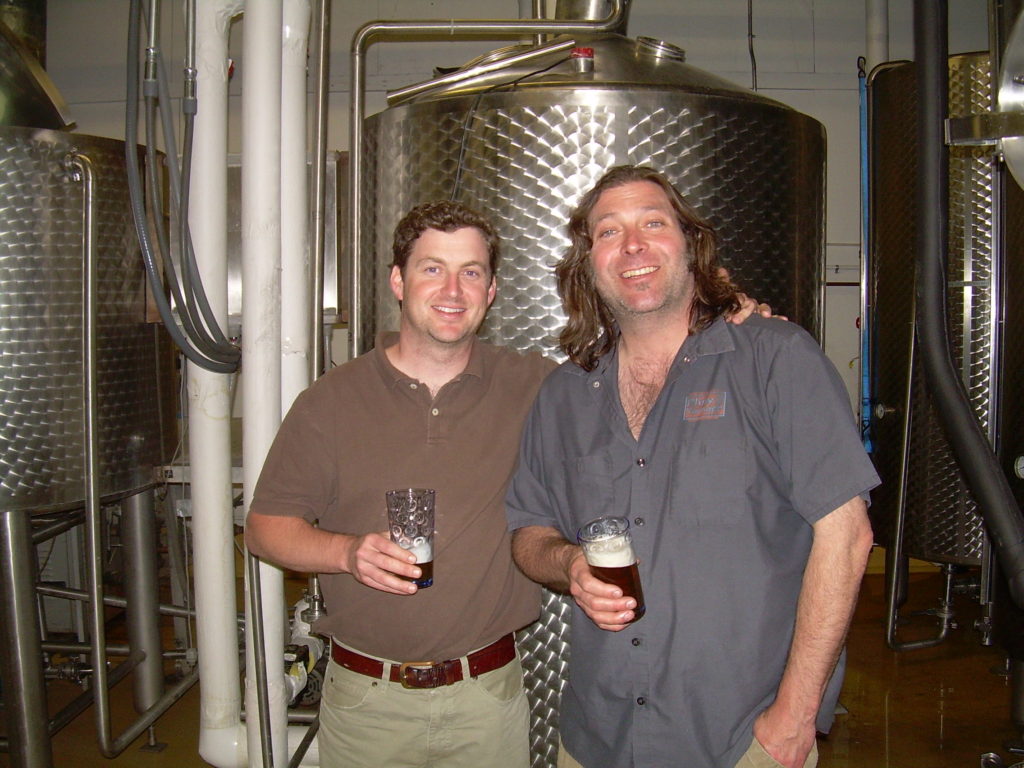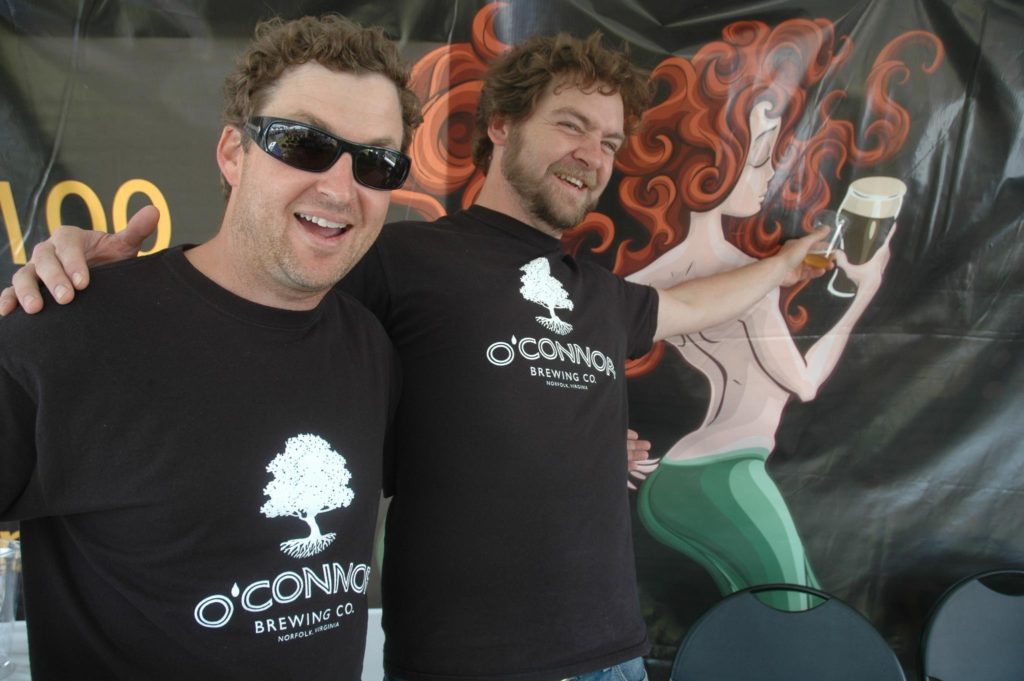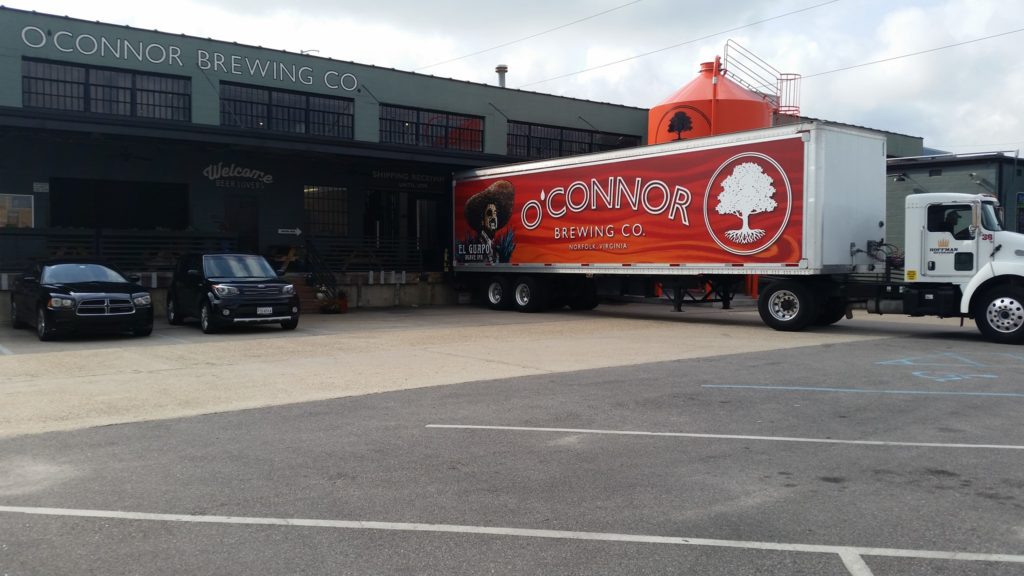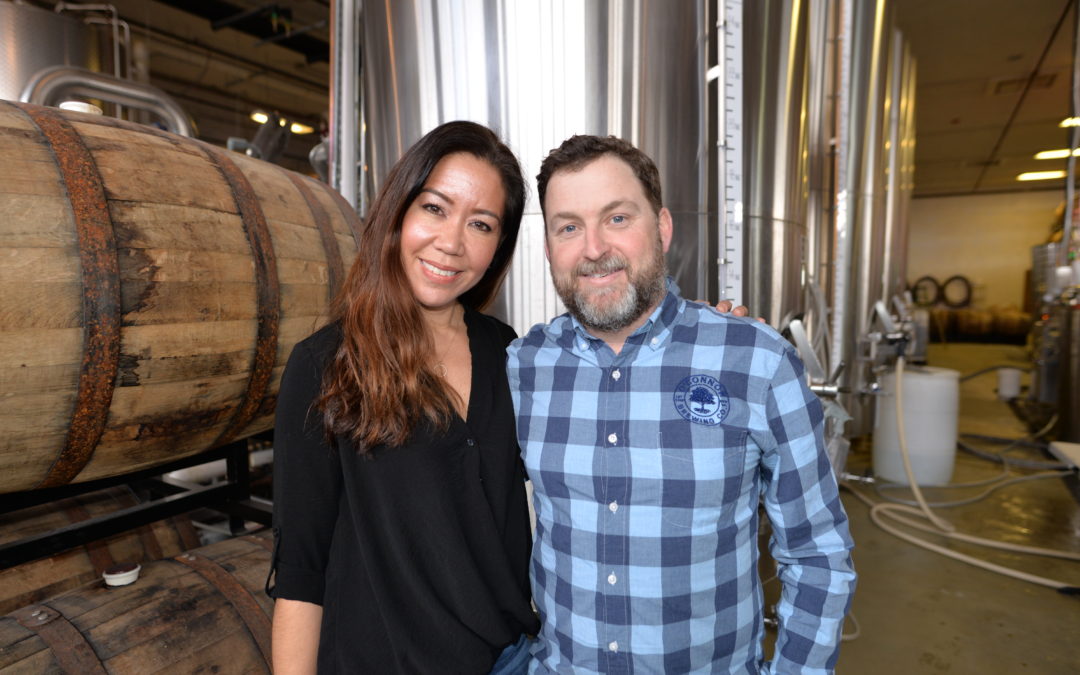(Penny & Kevin O’Connor in February 2020. Photo by Jeff Maisey)
By Jeff Maisey
A little luck of the Irish and a determined can-do attitude on St Patrick’s Day 2010 got O’Connor Brewing Company up and running with its first batch of beer.
In our mid-March 2010 issue of Veer Magazine, Diane Catanzaro wrote this: “Twenty-fifth Street in Norfolk, surrounded by Colonial Avenue to the east and Colley Avenue to the west, is one of those roads less travelled. Populated by relatively nondescript businesses, you’d have to look hard to discern what services are provided there. But if you meander among the warehouses in the 500 block, on a nondescript glass door on a yellow-green structure, you’ll find one decal and one small sign that are an indication of what you can discover inside. The decal reads ‘Brewer’s Association Member since 2010,’ and the sign simply states ‘O’Connor Brewing.’ That’s right, ale adventurer, Norfolk has a brewery. The first commercial brewery of any kind in Norfolk since the turn of the century.”
O’Conner Brewing Company started out producing what Catanzaro and husband Chris Jones described as “three nautical-themed draft beers.” Those were Green Can Golden Ale, Red Nun Red Ale, and Norfolk Canyon Pale Ale.
Those were somewhat pioneering days in Virginia as producers of beer had to either operate solely as a manufacturing plant or as a brewpub with full-service kitchen.
O’Connor decided to operate as a production facility, taking the same route as St George Brewing more than a decade before in nearby Hampton. As luck would have it, in 2012, founders of Virginia’s Craft Brewers Guild lobbied the General Assembly in Richmond and then-Governor Bob McDonnell signed a bill allowing breweries to operate tasting rooms.
The passage of SB604 proved a game-changer in Virginia and paved the way for hundreds of breweries to open for business.
Because O’Connor was in the game two years in advance, it provided a competitive advantage of being ahead of the pack.
Four years after opening, on the last Saturday in May 2014, the first O’Connoroo served as the Grand Opening Party at O’Connor’s current brewery at 211 W. 24th St.
As the craft beer industry has experienced rapid growth and change, O’Connor Brewing Company has not only kept pace but maintains the lead on all fronts — a strong core beer lineup of award-winning products, vast distribution, innovative limited release beers, concert entertainment and festival experiences, fundraising events, you name it.
O’Connor’s 10th Anniversary will not feature an event due to COVIC-19, however the brewery is open to the public. A special release of O’Connor’s Imperial Anniversary Stout barrel-aged in Irish whiskey is available.
In advance of the anniversary, I sat down with founding president Kevin O’Connor and his wife, Penny, who joined us later in the conversation.
Here’s what they had to share.
VEER: Much has changed in the Virginia brewing industry since you began ten years ago. It was before SB604 was signed into law allowing breweries to operate a tasting room, so you began as a manufacturing business. Can you take us back a decade and share your memories of the plans you had at the time?
Kevin O’Connor: I went to my first Craft Brewers Conference in 2009 in Boston. That’s where I met the guys that I bought the old, original (brewing) equipment from. It was definitely a different time.
We started out with a 5,000-square-foot building on 25th Street. We signed the lease in August of 2009 and started the build-out that September.
We brewed our first batch of beer on St. Patrick’s Day of 2010. That’s what we use as our anniversary.
There were a lot of 18-hour and 22-hour days getting everything ready to brew beer. I still remember that day (March 17, 2010). It was one of those hell-or-high-water we’re brewing beer kind of things. We didn’t even have our glycol chiller installed yet. The plumbers were pipping it in as we were brewing beer, and luckily the glycol chiller, which was a used piece of equipment, went off without a hitch.
As we were transferring beer into the fermentor the glycol started flowing and it kept the thing temperature controlled so we didn’t even have to dump that batch. It worked out very well for us.
I had no idea if this was going to be a successful business. I did not think we’d be where we are today as O’Connor Brewing Company. I didn’t think the industry would have grown as it crazy as it has. I figured we’d just keep chipping away. The explosive growth really is attributed to SB604 in Virginia, but just the whole trend going through that Great Recession with the resurgence of craft beer; I think it was good for us. It was, like, I think we can do this; let’s just try. It’s paying off right now.

(Kevin O’Conner and original brewer Chris O’Conner in 2010. Photo by Diane Catanzaro)
VEER: Let’s go back even further: What originally sparked your interest in brewing beer?
KOC: My whole story where I was a home brewer first — that’s a lot of people’s story.
I think coming from an entrepreneurial family — my dad owning his own business, my mom owning her own — we were set in a motion of creating your own destiny.
I goes back to college and thinking about what I wanted to do in life. I remember brewing my first batch of beer in college and having fun with it. I remember touring breweries like Dogfish at their early stage in life. Even driving over to St George (in Hampton) and going up to Starr Hill.
The difference between what my dad did, which was more retail focused, I really wanted to create something from the ground up that was different and create a product we could put to market.
There was something about the beer industry that got me moving in the right direction where there was nothing going on like this on the Southside (of Hampton Roads).
As I always tell my friends who came up after me, we were kind of forced into a game of being a production facility as a distribution-style business. You make beer, package beer, and sell it. I’d get out, drive around, talk to people, and hand-sell growlers. Luckily for us people liked the liquid. We established good partnerships with our wholesalers. We were really the first local beer into their wholesale network. I give a lot of props to Hoffman Beverage Company and the early-on wholesalers that dealt with us.
As SB604 came into existence that really was the floodgate for Virginia. When I saw that it was really going to pass we really had to change who we were. Morphing into a retail business, I think that’s where my father helped me out a lot. With my wife being on the marketing side coming up with branding ideas — T-shirts, hats, and all that stuff — that actually came later when we moved into the building we’re in now on 24th Street.
Over there (old building) it was, like, let’s just open the doors and see if people show up. And sure enough people started showing up.
It really wasn’t conducive to what I would consider the perfect retail setting. We were literally squeegeeing the beer off the floor. We were stepping over hoses. We would block things off with our bottle pallets or grain pallets. It was dark. It was dingy. Those were the days where I think back at how much fun it was because there was so much camaraderie. The people who worked with us to get us to where we are today; some of our older employees — Jimmy Walsh, Chris Knight (now at Guinness New Gate), Matt Tarpey (now at The Veil), Skylar (now at The Vanguard) — I still talk to those guys.
Then it got crazy where people (consumers) would show up all hours of the day. It got to a point where I was, like, we need to expand, not only on the retail side but we need to expand because production was growing.
In 2014, we relocated to this building (24th Street) and the rest is history — and we’re still writing it. This is the space that created that destination experience we were really striving for; a space that could be communal; a space that could have events; obviously a bigger retail space and a lot more production capacity.
At 10 years we’re still adding to our production; we’re still growing. This is still doing what we always dreamt it would do.

(Kevin O’Connor and brewer Jimmy Walsh enjoy a light moment at the Virginia Beer Festival. Photo by Maisey)
VEER: Since you mentioned the entertainment aspect of breweries — one of the things not foreseen with the passing of SB604 — do you see yourself as competition for restaurants, small concert promoters or event organizations?
KOC: So, first off, I believe over the last 10 years I’ve been in business this industry has gone from a beer focus to more of an experience. Craft beer is now more about the experience of it all because I think people are getting more behind the brands.
Before it was like this is cool, it’s local; this is good beer and I like it. Now it’s really getting the consumer engaged; telling them your story; getting them to be loyal fans. Yes, you still have to have great liquid and you have to have good marketing now, but at the end of the day you have to have something that will resonate with that consumer. And I think the space (tasting room, open view of brewing equipment etc) does that. You can see it; you can smell it; you can feel it.
And then getting your employees behind it and getting them excited about selling the product and talking us up. I can’t do everything. I know my name is on the building, but this is a 50-people deep business now.
As for competition, I’ve always looked at it through a different lens. I’m a very optimistic person. I would like to believe that O’Connor Brewing Company, as we’ve grown, that we have complemented the area. I really feel the way we run our business we shouldn’t be viewed as competition at all. We should be viewed as a compliment to the Festevents of the world; to the restaurants and other retailers around here.
We support all of the restaurants who have kept us onboard. We’ve lost a few restaurants along the way, maybe because they viewed it as competition. I never looked at it that way. We would always look for ways to partner with these groups. We really want to be part of the region as a whole and not viewed as combative or against it. That’s what I’ve set myself up to do. It does really hurt my feeling when I find out people take my taps down because of that perceived competition, but I really try to think of how I can gain their trust back or gain that business back by partnerships, by supporting them.
It’s amazing for me to go to places like Asheville where they have a population base of probably a quarter of ours, but they have five times the amount of breweries, and all of the local restaurants support them.
That’s where we need to be. For us, again, it’s how can we raise the whole community up?
VEER: You started O’Connor Brewing Company with a small group of core flagship beers. Some, like Norfolk Canyon, are still in production while others have be retired. How has your approach to flagships changed since opening, and with one brand in particular, El Guapo Agave IPA, accounting for the lion’s share of your sales in the marketplace?
KOC: Yeah, El Guapo’s still our lead horse.
When we started we were forced into a game of distribution. I’m going to be honest, I’m extremely excited to see what other breweries are doing. If I could do it all over again I don’t know if I’d do anything different, but I’d have the ability to start smaller and really be flexible about new beers constantly coming out.
As the industry expanded and as we expanded — sure — we had to keep turning out beers that were going into the grocery stores and volume bars. I don’t think anybody should hate me on that. It is — again — how I had to start this business.
Now, with SB604 and having the ability with tasting rooms, it was quickly apparent to me that we needed to do something not only for the consumer with ever-changing taste for what’s new and also keep the creative juices flowing not only in my own mind but giving the outlet of creativity to our production staff. So we’ve invested in a small, seven-barrel pilot system. That has been a lot of fun and a game-changer.
When we moved over here we were making 30-barrel batches of out Steel Battalion series. That was telling the world it’s not just El Guapo, it’s not just Norfolk Canyon, it’s not just Great Dismal. It’s look at this doppelbock we made. Look at this imperial stout we made.
I don’t like to believe we chase trends, but we listen to our customer a lot. And we do listen to our wholesalers.
When we sit there and hear, “You guys should really look into this,” it’s very difficult to sit back and make a big batch of something we’re not sure if it’s going to work or not.
Investing in a seven-barrel pilot system allows us to create new, one-off weird styles on a smaller scale, and be able to push them right into the tasting room and get that immediate consumer feedback. We then have the ability to monitor the sales.
Now, it’s become more of a R&D — Research & Development — project. We can take those beers and scale them up.
We’ve now moved our seasonal offerings into the grocery stores, and those now are ever-changing. It (pilot system) has put together our new series of beers called Hip Hop Anonymous.
The people out there like the hazy IPAs, so now it has turned into a new series of beers and the big grocery chains have gotten behind it.
Obviously the trend in the cans. We saw that coming. I wanted to do cans from the outset, but back then it was literally 99-percent of the people drinking out of bottles and turning their nose up at cans.
So, I think we made a good business decision moving into bottles, but I think we’ve transitioned more so into cans with our canning line. That’s proven successful.
We have been bobbing and weaving and pivoting the last 10 years, and I think that’s what’s kept our growth up. That’s what kept us innovative. I think that’s what keeps the consumers coming back. They believe we know how to make beer and pretty much do anything, whether it’s a hazy IPA to a traditional Irish stout. People trust our brand and that’s been a godsend for our business.

VEER: Do you envision a future need for a satellite production facility that would solely produce, say, El Guapo in mass quantities to free-up space as you reach full capacity in your current brewhouse?
KOC: Right now we’ve put the final touches on the plan for what this building can actually handle. We’re not there yet. We have a handful of more tanks to go.
If it ever got to that point I’d like to be able to tell myself I have the ability to either turn the volume up or down and kind of level this company out. I can start spending more time with my wife and kids. She works, obviously, in the business as head of marketing and my co-founder.
If it does keep the trajectory of what we’re doing that is actually one thought process.
Contract brewing a certain brand might be one process to get it further and further out.
The satellite (tasting room) model…I’ve seen too many people in Virginia closing with satellites of their own. I didn’t want to buy into that in Virginia because I was always one of those steadfast people with SB604 we really didn’t want to tick-off the restaurant groups, hoteliers and things like that.
Right now this facility is fine for us. We’ve been approached hundreds of times about satellites, and we’ve kicked tires on a few of them. But I think our brand translates a little bit further and we may be looking in other markets possibility for satellites on a smaller scale.
Right now it’s very easy to control what we do under one roof than it would be to have five satellites and me driving around the state to make sure everything’s running and keeping the O’Connor name in a good light.
VEER: O’Connor got onboard early with the hard seltzers and had success with the limited supply you produced. Will you expand/increase your seltzer production for summer 2020? Also, non-alcoholic beers are a gaining trend in the craft market. Is this something you’re looking into?
KOC: I believe the BFY — Better For You — beer and health consciousness is a real thing. My wife and I talk about it all the time: What is the next phase?
I believe that Sober Curious is a real thing. I think the low-cal, low carb beers are going to keep skyrocketing. I think Founders All Day IPA really hit that home.
So, yes, we are researching on our pilot system.
Seltzers…I’d like to bring ‘em back. We have some we’re blending and are going to be putting them on the shelf. Getting them to market in mass production, that’s a challenge I put to the brewers and how we can do that in a timely, economical fashion. That brand is more or less the brainchild of my wife and marketing. I thought it was a perfect package. It did well when we initially launched it.
Last year was the summer of seltzer and I think it’s got about three to five years before it levels itself out. I do believe seltzer will not go anywhere. I mean look at Mike’s Hard Lemonade and things like that. I just don’t know if it’s ever going to overtake craft beer as a whole.
Penny O’Connor: It’s a category like Gluten-Free. It’s something that will continue to grow as these Baby Boomers, Gen Xers get a little older and may have some gluten sensitivities. There is a market for that, but our focus is on making great beer.
VEER: You’re 10 years into your business. What does the next decade look like for O’Connor Brewing Company?
KOC: I think we’re on the right track for the next 10 years. We do have a general manager in place; he’s our operations manager. He’s got a lot of knowhow. We have a lot of trust in him.
I think we’ve got a really great team here. We can rely on it and take vacations with our kids. We’ve gotten to the point where we can take weekends off and don’t have to worry about too much.
For the industry in the next 10 years: I think we’re going to get back to basics in craft beer. I think lager will finally resonate with everybody. I think the IPA category will continue to branch around and be fun. I think the pastry style craze will still be that percentage.
I think the next round of drinkers are going to come up and want that Better For You healthy option. I think that’s got a lot of legs. And I think non-alcoholic has a real fighting chance over the next five, ten years.
POC: It’s hard to predict. The thing that has remained constant in our industry is that nothing ever stays constant. Every year there’s something new.
Kevin mentioned experience. That is another thing we’ve tried to do, which is try to evolve our experiences here at the brewery. I hope we in the future come back to the basics socially where people are coming to the brewery as their third space.
VEER: Are there two or three best moments from your first 10 years you’d like to share?
KOC: For me it was St Patrick’s Day 2010 and brewing our first batch of beer. I can still remember that day. I remember driving back 14 hours from uninstalling our original equipment to unload the truck. Those were crazy days.
Winning awards is very cool upfront but I get more of a kick when I see people who are unlikely craft beer drinkers stop me and say, “I love your beer.”
There was a shipyard drink at AW Shucks back in the day and I was the only one in the bar. I was having a sandwich and a beer, and some guy came in. He was in his 50s yelling, “Give me that O’Connor beer.” He said he used to drink big domestic beer, but I love your beer and I’m now a fan for life. I thought that was awesome. That means we’re doing something right to gain those types of fans.
POC: I think moving into this building was an unforgettable milestone — the first O’Connoroo.
More info at:




